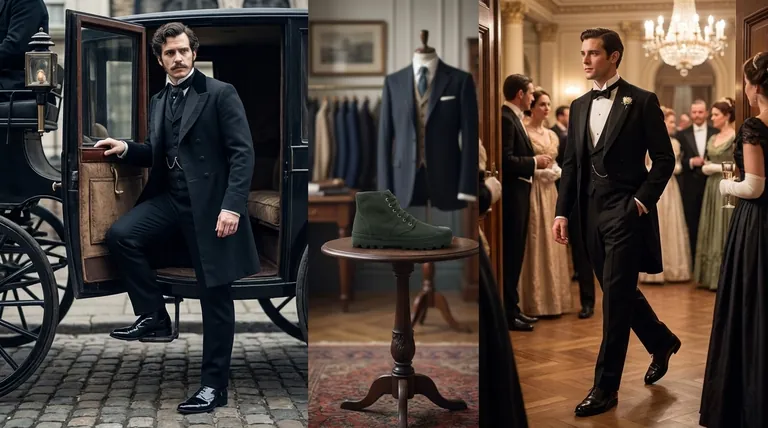In short, the use of men's dress boots evolved from a broad formal standard in the Victorian era to a more specialized and context-dependent choice during the Edwardian period, with a clear trend towards being replaced by shoes for many occasions. The primary shift was not in the boot's design, but in the social rules governing when and where it was appropriate to wear one.
The core evolution of the dress boot between these two eras was its transition from a default choice for formal wear into a niche item. The strict new dress codes of the Edwardian period dictated specific styles for day versus evening, paving the way for the modern dominance of the dress shoe.

The Victorian Era: The Formal Boot as Standard
Before the Victorian period, long riding boots were a common sight in daily life. The rise of more distinct social occasions in the 19th century created a need for more refined, dedicated formal footwear.
The Default for Dress Occasions
During the Victorian era, the shorter dress boot became the established standard for formal and semi-formal attire. It was a versatile staple, appropriate for a wide range of functions.
The Primacy of Calf and Patent Leather
These boots were typically crafted from two key materials: black calf leather for a more subdued, all-purpose formality, and high-shine patent leather for more glamorous evening events.
The Edwardian Shift: Specialization and Decline
The Edwardian era is known for its highly specific and rigid dress codes. This sartorial precision had a direct impact on the role of the dress boot, limiting its use and creating a sharp distinction between day and evening wear.
The Decline of Patent Leather for Daywear
A significant change was the move away from shiny footwear during the day. Patent leather was deemed too flashy, and formal morning clothes were instead paired with boots made of plain calf or, increasingly, with dress shoes.
The Niche Role of the Evening Boot
In the evening, the patent boot found a new, highly specific role. It became the correct footwear for formal evening occasions where no dancing was expected.
The Ascendancy of the Dress Shoe
For nearly every other situation, especially those involving dancing, the dress shoe began to replace the boot. This trend marked the beginning of the boot's decline as the primary formal footwear, with court slippers also giving way to shoes for events like white tie.
Understanding the Driving Forces
This evolution wasn't arbitrary; it was driven by practical needs and a broader shift in social etiquette. Understanding these forces provides the context for why these changes occurred.
Practicality and Comfort
Shoes are generally lighter and offer more ankle flexibility than boots. For activities like dancing, which became a central part of many social functions, the dress shoe was simply a more practical and comfortable choice.
The Codification of Modern Dress
The Edwardian era solidified the menswear rules that still influence us today. The move towards specific footwear for specific times of day and activities was part of a larger trend toward sartorial precision and a more defined, modern wardrobe.
Making the Right Interpretation
To understand this sartorial evolution, focus on the context in which the footwear was worn.
- If your primary focus is the Victorian period: View the dress boot as a versatile and dominant staple for nearly all formal occasions.
- If your primary focus is the Edwardian period: Recognize that the rules became highly specific, relegating plain calf boots to daytime and patent boots to non-dancing evening events.
- If your primary focus is the overall trend: See this transition as the pivotal moment when the dress shoe began its century-long rise to replace the boot as the default for formal wear.
This evolution from a general-purpose staple to a specialized item reflects a wider societal shift toward the structured, practical dress codes of the modern era.
Summary Table:
| Era | Primary Footwear for Formal Occasions | Key Materials & Styles | Key Trend |
|---|---|---|---|
| Victorian | Dress Boots | Black Calf Leather, Patent Leather | Versatile staple for most formal events |
| Edwardian | Dress Shoes (ascending) | Plain Calf (day), Patent Boots (non-dancing evening) | Specialization; boots become context-dependent |
Looking for high-quality, historically-inspired footwear?
As a large-scale manufacturer, 3515 produces a comprehensive range of footwear for distributors, brand owners, and bulk clients. Our production capabilities encompass all types of shoes and boots, from classic leather dress boots to modern formal shoes, ensuring quality and authenticity for your brand.
Contact us today to discuss your production needs and let us bring your footwear vision to life.
Visual Guide

Related Products
- Factory-Direct Wholesale Canvas Boots with High-Traction Rubber Soles
- Wholesale High-Traction Camo Boots - Custom Manufacturer for Brands
- Wholesale Classic Leather Lace-Up Ankle Boots for Brand Manufacturing
- Factory Direct Wholesale Rain Boots Durable Waterproof & Fully Customizable
- Wholesale Durable Mid-Cut Tactical Boots for Custom & Private Label Brands
People Also Ask
- What role do slip-resistant rubber materials play in safety shoes? Ensuring Grip and Stability in Hazardous Workplaces
- Why is rubber commonly used for non-slip soles? The Science of Superior Grip
- What types of rubber are typically employed in non-slip footwear soles? Your Guide to Maximum Grip and Safety
- Why are rubber soles beneficial in cold-weather boots? Superior Traction & Waterproofing
- What is a vulcanized sole? Discover the Secret to Superior Flexibility and Grip



















